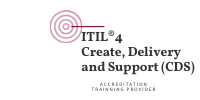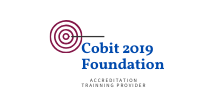ITIL® 4 DITS


ITIL® 4 Strategic DITS – Leader Digital & IT Strategy
- Introdução
O módulo ITIL® Leader Digital & IT Startegy foca a importância e os desafios da criação de uma estratégia digital apropriada para permitir o sucesso das empresas e como ela pode (e deve) ser integrada à estratégia de TI e alinhada com os objetivos da Organização. Explora o uso da estrutura ITIL® para apoiar as organizações em suas atividades digitais na sua jornada de transformação, fornecendo uma abordagem estruturada e flexível para abordar os desafios do gerenciamento moderno de serviços e utilizando o potencial das tecnologias modernas para obter o máximo valor da tecnologia digital. Isso também adiciona uma nova perspectiva ao framework ITIL® e eleva a discussão em torno dos conceitos de ITIL® para os níveis mais estratégicos entre empresas e líderes de negócios.
Os principais resultados desta capacitação são:
-
- Demonstrar o uso dos princípios orientadores do ITIL® as decisões e atividades do DITS - Digital and IT Strategy;
- Entender porque as organizações precisam mudar seus modelos de negócio para prosperar em mercados “disruptivos” pelas tecnologias digitais e da informação e relacionar isto aos conceitos de estratégias que elas precisam dominar na condução das mudanças requeridas pela transformação digital;
- Relacionar os conceitos de DITS - Digital and IT Strategy, de SVS – Service Value System e Service Value Chain e como eles trabalham juntos para criar value em mercados que estão sendo transformados pelas tecnologias digitais e da informação;
- Entender como uma organização usa DITS - Digital and IT Strategy para permanecer viável em ambientes “disruptivos” pelas tecnologias digitais e da informação;
- Entender as abordagens estratégicas possibilitadas pela tecnologia digital e da informação para alcançar o cliente, o mercado e a excelência operacional;
- Entender os riscos e oportunidades do DITS -Digital and IT Strategy;
- Entender os passos e técnicas envolvidas na definição e defesa de estratégias digitais e estratégias de TI;
- Entender como implementar DITS - Digital and IT Strategy.
Carga Horária do Curso: 32 horas
Pré- requisitos: Certificado ITIL® 4 Foundation e no mínimo, 3 anos de atuação em cargos de Gestão. Inglês para leitura e interpretação para a realização do exame.
Conteúdo Previsto: macro temas
1. Demonstrate the use of ITIL Guiding Principles in Digital and IT Strategy decisions and activities:
1.1 Relate the ITIL guiding principles to all aspects of Digital and IT Strategy:
a) Focus on value
b) Start where you are
c) Progress iteratively with feedback
d) Collaborate and promote visibility
e) Think and work holistically
f) Keep it simple and practical
g) Optimize and automate
2. Understand why organizations need to change the way they do business in markets disrupted by digital and information technology, and relate this to the concepts of strategy that they will need to master as they make these changes:
2.1. Understand the following concepts:
a) Digital Technology
b) Digital Business
c) Digital Organization
d) Digitization
e) Digital Transformation
2.2 Understand the following concepts:
a) Business Strategy and Business Models
b) Digital and IT Strategy
c) Product Management
d) Service Management
2.3 Explain the relationship between Digital and IT Strategy and the core components of the ITIL SVS,Strategy Management practice
3. Relate the concepts of Digital and IT Strategy, the Service Value System and the Service Value Chain and explain how they work together to create value in markets being transformed by digital and information technology:
3.1 Explain environmental analysis in terms of:
a) External analysis: PESTLE
b) Internal analysis: The Four Dimensions of Service Management
4. Understand how an organization uses Digital and IT Strategy to remain viable in environments disrupted by digital technology:
4.1 Show how an organization’s viability is related to how agile, resilient, lean, continuous and co-creational it is;
4.2 Know how to apply Digital and IT Strategy in managing VUCA environments;
4.3 Explain and compare three levels of digital disruption:
a) Ecosystem;
b) Industry/market ;
c) Organizational .
4.4 Show how an organization’s position in a particular market or industry is influenced by the following factors:
a) Achieving customer/market relevance;
b) Achieving operational excellence;
c) Internal and external focus;
d) Balanced approach;
4.5 Use a digital positioning tool to determine the appropriate position for a digital organization
5. Understand strategic approaches made possible by digital and information technology to achieve customer / market relevance and operational excellence:
5.1 Know how to apply the following approaches to achieve customer / market relevance:
a) Customer journeys;
b) Omni-channel delivery and support;
c) Context-sensitive delivery and support;
d) Customer analytics;
e) Customer feedback and 360 approaches;
5.2 Know how to achieve operational excellence in the four dimensions of service management;
5.3 Understand the financial aspects of Digital and IT Strategy in terms of the following:
a) Financial policies, Service Financial Management practice;
b) Portfolio optimization, Portfolio Management practice;
c) Funding projects, products and services;
d) Balancing the cost of innovation and operation;
e) Charging models, Service Financial Management practice
5.4 Apply strategic approaches for digital organizations
6. Understand the risks and opportunities of Digital and IT Strategy:
6.1 Explain the concept of risk management in the context of a digital organization;
6.2 In the context of Digital and IT Strategy, explain how to:
a) Identify risk;
b) Assess risk;
6.3 Explain the concept of risk posture and show how to determine an acceptable balance between opportunity and risk;
6.4 Explain the concept of innovation, including its key elements and techniques;
6.5 Describe techniques to develop and maintain a culture of innovation;
7. Understand the steps and techniques involved in defining and advocating for a Digital and IT Strategy:
7.1 Show how to use a digital readiness assessment to perform a gap analysis between an organization’s current and desired positions;
7.2 Explain how to define and communicate a vision and a strategy;
7.3 Know how to use business cases to advocate for a Digital and IT Strategy.
8. Understand how to implement a Digital and IT Strategy:
8.1 Know how to define operating models for digital organizations;
8.2 Explain the major skills required of leaders in a digital organization;
8.3 Apply the following approaches to strategy coordination and implementation:
a) Large-scale transformation;
b) Incremental transformation;
c) Mergers and acquisitions;
d) Individual changes;
8.4 Explain approaches to POM (parallel operating model)
8.5 Explain how to assess success of a Digital and IT Strategy
8.6 Explain the typical activities of a digital transformation program
Visão geral do exame: em inglês
|
Material Permitido |
Nenhum |
Exame sem consulta A publicação ITIL® 4: Digital IT Strategy e a documentação sobre as práticas contidas nos guias de práticas do ITIL® deve ser usada apenas para estudo anterior ao exame.
|
|
Duração do exame |
60 minutos |
Candidatos que fazem o exame em um idioma que não é idioma de origem ou de trabalho podem receber 25% de tempo extra, ou seja, 75 minutos no total. |
|
Número de perguntas |
30 |
Existem 30 perguntas, cada uma valendo 1 marca. Não há marcação negativa. |
|
Aprovação |
21 |
Candidatos precisam acertar 21 questões (70%) para passar no exame. |
|
Nível de pensamento |
Níveis 2 e 3 da escala de Bloom |
"Nível de Bloom" descreve o tipo de pensamento necessário para responder à questão. Para as perguntas de Bloom nível 2, os candidatos precisam mostrar entendimento dos conceitos, métodos e princípios do DITS. Para as perguntas de Bloom nível 3, os candidatos precisam demonstrar a aplicação desses conceitos, métodos e princípios do DITS, bem como informações das práticas relacionadas. |
|
Tipos de questões |
Clássico padrão, Negativa e Lista |
As perguntas são todas de "múltipla escolha". Para as perguntas "clássicas padrão", os candidatos têm uma pergunta e quatro opções de resposta. Perguntas "negativas" são perguntas "padrão" nas quais o radical é negativamente redigido. Para as perguntas da "lista", há uma lista de quatro declarações e candidatos precisa selecionar duas instruções corretas da lista. |
- Visão geral do estudo de caso
|
Material Permitido |
Qualquer |
Esta é uma avaliação com consulta Qualquer material disponível é permitido que seja utilizado durante a atividade, incluindo a publicação ITIL® 4: Digital IT Strategy e a documentação sobre as práticas contidas nos guias de práticas do ITIL. |
|
Duração do exame |
Variável |
Duração: Três atividades práticas de 60 minutos, uma de 90 minutos em grupo ou, Quatro atividades práticas escritas individuais de 60 minutos cada. |
|
Número de perguntas |
40 |
Número de atividades práticas: 4 Número de critérios de avaliação: 5 Marcas: Cada critério de avaliação tem 8 pontos, completando 40 pontos no total. Não há questões negativas. |
|
Aprovação |
30 |
75% ou mais. |
|
Nível de pensamento |
Nível 4 da escala de Bloom |
Para as perguntas de Bloom nível 4, os candidatos precisam analisar as informações fornecidas e julgar se um curso de ação é eficaz e apropriado. |
|
Tipos de questões |
Tarefas |
Todas as 4 atividades são baseadas em um estudo de caso que descreve 3 empresas engajadas em relacionamento de serviços. Todas as atividades endereçam dois critérios de avaliação (ACs). Existe um critério de avaliação (AC) dedicado onde todas as atividades focam o qual é o AC 1.1 ‘Relacionado aos princípios orientadores do ITIL® para todos os aspectos do DITS – Digital IT Strategy. |



